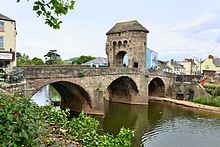Monnow Bridge
|
Monnow Bridge Pont Trefynwy |
|
|---|---|

View of the bridge looking north
|
|
| Coordinates | 51°48′32″N 2°43′12″W / 51.8090°N 2.7200°WCoordinates: 51°48′32″N 2°43′12″W / 51.8090°N 2.7200°W |
| Carries | pedestrian traffic |
| Crosses | River Monnow |
| Locale | Monmouth, Monmouthshire, Wales |
| Characteristics | |
| Design | Bridge tower |
| Total length | 34.80 m (114.2 ft) |
| Width | 7.30 m (24.0 ft) |
| Number of spans | 3 |
| Piers in water | 2 |
| History | |
| Construction begin | 1372 |
|
Listed Building – Grade I
|
|
| Official name | Monnow Bridge and Gateway |
| Designated | 15 August 1974 |
| Reference no. | 2218 |
Monnow Bridge in Monmouth, Wales crosses the River Monnow (Welsh: Afon Mynwy) some 500m above its confluence with the River Wye. It is the only remaining fortified river bridge in Great Britain with its gate tower standing on the bridge. Such bridge towers were common across Europe from medieval times but many were destroyed as a consequence of diminishing defensive requirements and the increased demands of trade and traffic. The bridge's historical and architectural importance is reflected in its status as a Scheduled Monument and a Grade I listed building.
Begun, according to tradition, in 1272, the stone bridge replaced a twelfth-century Norman timber bridge. From its construction, it played a significant, if ineffectual, role in the defences of Monmouth, in the medieval era, in the English Civil War and during the Chartist uprising. It also served as a gaol, a munitions store, a lodge, an advertising hoarding and, most significantly, as a toll gate. Much of the medieval development of the town of Monmouth was funded by the levies the borough was entitled to raise though Royal charter.
Built predominantly of Old Red Sandstone, the bridge was the subject of significant reconstruction and rebuilding in the eighteenth, nineteenth and twentieth centuries. It also suffered increasing damage, as higher volumes of traffic and the use of ever-larger vehicles in the twentieth century led to a number of serious accidents. In the twenty-first century, the building of a new road bridge to the south enabled the pedestrianisation of the bridge.
The existing bridge was completed in the late thirteenth century, traditionally in 1272 though this date has no supporting documentary evidence. The Monmouth antiquarian Charles Heath, writing in his Historical and descriptive accounts of the ancient and present state of the town of Monmouth published in 1804, recorded that its "foundation is so ancient that neither history or tradition afford any light respecting the date of its erection." Heath drew directly from the earlier guide to The Antiquities of England and Wales written by Francis Grose and published in 1787. Jervoise suggested that the absence of an evidential record was due to the destruction of "the archives of the Duke of Beaufort at Raglan Castle in the seventeenth century." However, it should be noted that the gatehouse did not come into the possession of the Somersets until the nineteenth century.
...
Wikipedia

